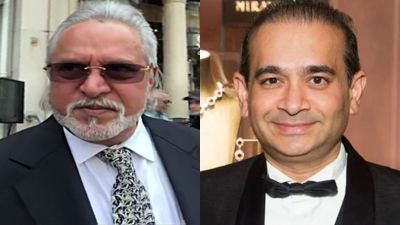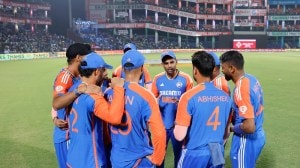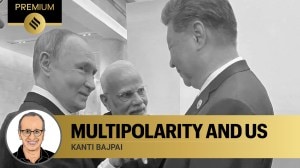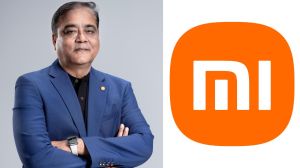Surabhi Dahiya’s ‘Indian Media Giants’ offers glimpses into how the Indian media has evolved since Independence
Through examples, anecdotes and interviews with six media houses, including The Indian Express, the writer traverses their strategies, growth and contribution to India’s socio-cultural landscape, writes Ramesh Menon
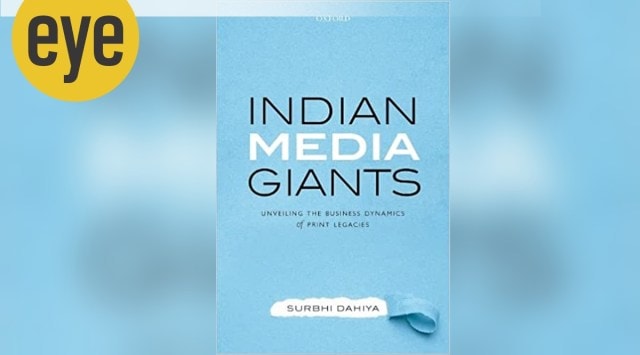 Indian Media Giants: Unveiling the Business Dynamics of Print Legacies; Surabhi Dahiya; Oxford University Press; 1040 pages; Rs 3475 (Photo: Amazon.in)
Indian Media Giants: Unveiling the Business Dynamics of Print Legacies; Surabhi Dahiya; Oxford University Press; 1040 pages; Rs 3475 (Photo: Amazon.in) What was the Indian media like before Independence? What idealistic fervour did it have then, and what does it stand for today? How did numerous media giants grow from humble beginnings? Surabhi Dahiya attempts to uncover this in Indian Media Giants: Unveiling the Business Dynamics of Print Legacies. The 1040-page tome traverses the journey of six major media houses, their strategies and growth.
Through examples, anecdotes and interviews, she takes us through the time before Independence when the media primarily advocated for emancipation from British rule and focussed on nation-building after attaining freedom. Starting a newspaper before Independence was synonymous with the freedom movement, and profits were not on the horizon. The idea was to motivate people and make them think. However, it soon metamorphosed into a business proposition where profits mattered in a commercialised eco-system that punctuates the media today.
The six media houses featured are Bennett Coleman and Co.Ltd., (The Times of India), Indian Express Group, HT Media Limited (Hindustan Times), Kasturi and Sons (The Hindu), Jagran Prakashan Limited (Dainik Jagran) and DB Corp. Limited (Dainik Bhaskar ). They started small and then expanded with more editions and regional languages. It then moved into areas like TV, radio, websites, outdoor advertising, business enterprises like events and conferences, and even beauty pageants designed to generate more money.
After Independence, The Times of India launched a Hindi daily to expand into regional areas. Dainik Bhaskar, which launched its Hindi newspaper in Bhopal in 1958, soon had Gujarati and Marathi editions, becoming the third-largest circulated newspaper in the world. It moved to different states catering to local audiences. Similarly, Jagran Prakashan published 10 titles in five languages in 13 states. The Hindi readership overtook the English one.
In the ’50s, Indians loved reading about politics, but business journalism got a boost in the ’60s with the entry of The Financial Express and The Economic Times. New publications like India Today arrived in the ’70s, changing the magazine scenario.
When then Prime Minister Indira Gandhi declared an emergency in 1975, that lasted 21 months, censorship was imposed on the media. Ramnath Goenka’s The Indian Express, which was critical of the government’s move, came under government pressure. “There were accounts to acquire the paper, tax demands designed to undermine its financial viability and overt encouragement of advertisers to withdraw,” Dahiya writes. The Indian Express and Statesman left their editorials blank to register their protest. Around 7,000 journalists were arrested.
Liberalisation helped media organisations cross barriers that earlier stopped them from expanding, forging joint ventures, innovation and diversification. Secondly, the New Economic Policy of 1991 helped media organisations to change. Radio and television got privatised, with spectrum being auctioned for radio and licensing being available for television. Media took the commercial route, consequently attracting foreign investment and public funding.
 While there were interesting nuggets of information, the author struggles to analyse how the media functions today. Dahiya could have highlighted why and how good and serious journalism struggled to survive while puerile journalism flourished. (Photo: Amazon.in)
While there were interesting nuggets of information, the author struggles to analyse how the media functions today. Dahiya could have highlighted why and how good and serious journalism struggled to survive while puerile journalism flourished. (Photo: Amazon.in)
The Times of India moved into television, radio, feature films and online services in property, cars, jobs and even matrimonial help to explore new sources of revenue. There were also price wars with newspapers like The Times of India being sold at Rs. 1.50, which resulted in doubling sales and killing competition.
The paper integrated information, news, advertising and product promotion. In return for coverage, the group also started charging companies creating a system allowing companies to pay for advertising with equity states or property rights. Other media groups followed suit getting into areas like outdoor advertising. Commercially inclined supplements full of ads and advertorials were supplied with the main newspaper.
Many media firms like The Indian Express and The Hindu became giants traversing market realities and pressures. The trend of media convergence acquired a central stage in the post-millennium era. This happened as the entertainment and media industry flourished, experimenting with innovation and technology.
The media industry flourished due to new technology and the relaxation of licensing norms. The audience started dictating what they wanted. Many started viewing media as a means of entertainment. Private television channels mushroomed challenging the monopoly of Doordarshan. Today, there are over 915 channels. Regional language newspapers also innovated with colour pages as local market forces capitalised on the fruits of liberalisation. In 1995, a Supreme Court judgment overruled the government monopoly over radio leading to a spurt in FM channels.
With the internet coming, information was readily available at the touch of a smartphone. The media could not be sluggish anymore. It had to keep reinventing itself using convergence to cater to all needs and tastes. The media scenario sent out a clear message at the turn of the millennium: Change or quit.
The Hindu and The Indian Express were among the first to launch their web editions in the mid-’90s. By 2014, all major newspapers and news channels had online versions while several digital-only news websites like The Quint, The News Minute, ScoopWhoop, Scroll and The Print made waves. It created a new brand in journalism. By 2019, India had become the largest smartphone data-consuming country in the world. Naturally, digital advertising rose from Rs. 15.4 billion in 2011 to Rs. 221 billion in 2020.
It has been a tumultuous journey. The Hindu was started in 1878 by six teenagers who collected one rupee and six annas in 1878 to start The Hindu. It went on to become a respected newspaper and, at one time, had 12 foreign correspondents. In its early run in the 19th century, The Times of India was bought by two large circulating libraries allowing each reader three hours. In the evening, it would be ironed and dispatched to mofussil areas. The Hindustan Times started in 1924, intending to fight for Independence. Its price: six paise.
While there were interesting nuggets of information, the author struggles to analyse how the media functions today. Dahiya could have highlighted why and how good and serious journalism struggled to survive while puerile journalism flourished. Or, how the freedom of the press was in peril. Instead, she solely relies on interviews with owners, editors and other media professionals to tell the story. So, we just get their versions. One could not help remembering an oft-repeated quote while reading the book: “News is what somebody does not want you to print. All the rest is advertising.”
Ramesh Menon is an author, journalist, filmmaker and corporate trainer. He is an adjunct professor at Symbiosis Institute of Media and Communication, Pune
Photos





- 01
- 02
- 03
- 04
- 05

